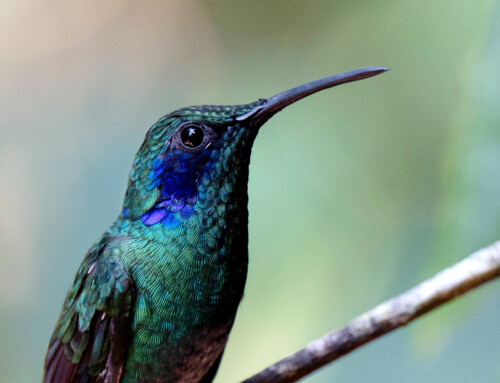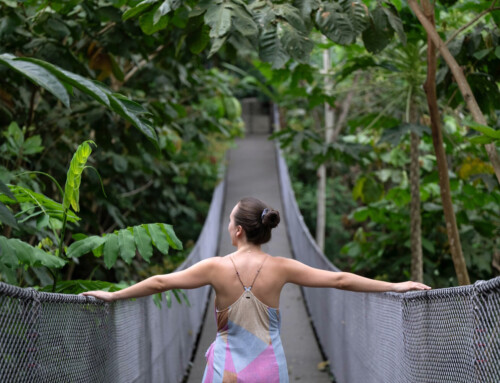A road trip is the best way to explore Costa Rica’s natural wonderland. In this post, I’ll detail our experience in the La Fortuna region, including our immersive resort stay with volcano views, searching for sloths, and our adrenaline-pumping ziplining experience. For our full itinerary and general travel tips for the country, be sure to check out my first post in this series.
La Fortuna is a gateway to one of Costa Rica’s most iconic natural wonders—Arenal Volcano. Towering above the lush rainforest, this majestic volcano creates a dramatic backdrop for adventure and relaxation alike. From the soothing embrace of natural hot springs to the rush of waterfall hikes and thrilling zipline rides, La Fortuna offers a perfect blend of excitement and tranquility. Whether you’re chasing adrenaline or simply soaking in the views, this vibrant town is sure to leave you enchanted. Ready to explore? Let’s dive in.
Our Enchanting Stay at Nayara Gardens
Tucked away in the lush rainforest near Arenal Volcano, Nayara Gardens Resort is a sanctuary of luxury and tranquility. This award-winning resort offers world-class hospitality and is one of the nicest hotels I have ever stayed in. The property boasts several restaurants, each serving excellent cuisine crafted from local ingredients. Every spacious casita is nestled within a private rainforest setting—some with sweeping volcano views—and features upscale modern amenities, including an outdoor jacuzzi on the terrace and an outdoor shower.
Nayara Gardens (family-friendly), Nayara Springs (adults-only), and Nayara Tented Camp (upscale luxury camping) are all part of the Nayara Resorts Collection. Staying at any of these properties grants you access to all the amenities of the others, including the restaurants and pools. The staff is incredibly kind and helpful, frequently checking in to ensure you know where you’re going since the winding paths can be confusing and tiring when walking uphill. Fortunately, golf carts are always available to take you where you need to go.
Exploring the Resort
Walking the paths through Nayara Resorts is like stepping into a vibrant rainforest sanctuary. Towering trees shade the winding stone trails, and lush foliage lines the pathways, with heliconias, bromeliads, and orchids adding splashes of color. The resort’s signature bridges, some suspended above serene koi ponds or gentle streams, offer peaceful moments to pause and soak in the scenery. At night, lanterns softly illuminate the paths, casting a warm glow that enhances the romantic ambiance. The occasional chorus of tree frogs and the hum of the rainforest create a soothing soundtrack for your stroll. Now and then, the Arenal Volcano peeks out from amidst the clouds and greenery for a majestic moment.
The land where Nayara Resorts now exists was once a barren cattle ranch without a single bird or shrub to speak of. Designed with a strong commitment to sustainability, luxury, and a deep respect for the surrounding environment, the resorts were built using eco-friendly practices, incorporating sustainable materials and minimizing environmental impact. Architects and designers worked closely with environmental experts to ensure that construction would not only preserve the natural rainforest habitat, but actually contribute positively with a massive reforestation effort.
As stated in Nayara’s blog post about regenerative tourism, “we took it upon ourselves to bring the rainforest back to this desolate landscape, and so we planted hundreds of indigenous trees and plants creating a habitat for countless wildlife in the process. This included dozens of crecopia trees, a sloth favorite, that turned our resort into a veritable sloth sanctuary. But creating a habitat for wildlife was just the first step. After a rigorous multi-year effort, we were able to become fully carbon neutral. We calculate and offset all our greenhouse gas emissions so you can enjoy and preserve nature at the same time.” This massive reforestation effort is inspiring and incredible to think about as you walk the resort paths and meet all sorts of wildlife.
Among our lucky animal encounters was a strawberry poison dart frog. This tiny yet striking amphibian is native to Central America. Its vibrant red body and contrasting blue legs resemble denim, earning it the nickname “blue jeans frog.” While its poison can be harmful to predators, it poses no significant threat to humans unless ingested or handled with broken skin.
Searching for Sloths
Finding sloths at Nayara is a full-fledged activity. The “Daily Sloth Patrol” map keeps track of where these adorable animals have last been seen on the property. The resort also offers nature walks with experts, who know all the key places to find them.
Sloths are often home to algae and small insects that live in their fur, giving them a greenish tint. This symbiotic relationship benefits both the sloth (by providing camouflage) and the algae (which thrives in the moist fur environment).
Spotting a sloth is a rewarding experience, but it requires a bit of patience and a trained eye. Here are some tips to help you find them:
- Look up in the treetops — Sloths spend most of their time high in the tree canopy. Scan the branches for round, furry shapes, as they often resemble clumps of moss or nests.
- Focus on cecropia trees — With large, umbrella-like leaves and thin trunks, these trees are a favorite food source for sloths and make them easier to spot.
- Go early or late — Sloths are typically more active during the early morning or late afternoon.
- Watch for movement — Sloths move very slowly, but a slight shift of a limb or their head may catch your eye.
I was curious about the distinct striped markings on the backs of some of the sloths, and learned that male three-toed sloths have these for a few purposes; sexual signaling (makes males more noticeable to females during mating season), health indication (a well-defined stripe signals a healthy, mature male, making him more attractive to potential mates), and camouflage (the stripe can help blend into the light and shadow patterns of the canopy, offering some protection from predators like eagles and jaguars. Nature always has a reason!
Soaking in Paradise
There were many pools to choose from on property, but our favorite was the infinity pool at Nayara Tented Camp overlooking the rainforest and Arenal Volcano. Fed by natural thermal waters, it’s clear the pool was designed for a luxurious and immersive experience.
The volcano view from the pool is nothing short of breathtaking. While we relaxed in the warm, mineral-rich water, the majestic Arenal Volcano rose dramatically in the distance as a perfectly symmetrical cone, framed against the vibrant blue sky with wisps of clouds drifting around its peak. In addition to ideal views, the food served poolside is sublime.
When it rains, it pours. On rainy days, the mist engulfs the volcano view, gradually making even the lush rainforest disappear around us. What we thought might be a disappointing experience turned out to be magical. Rain feels different in Costa Rica, and we found ourselves swimming and dancing in it.
We warmed up with a dip in the resort’s amazing thermal mineral pools, naturally heated by volcanic springs and rich in therapeutic minerals. Surrounded by vibrant rainforest foliage, the pools were rejuvenating and conveniently located near the swim-up bar, where we took shelter when the rain began to fall more intensely.
Our stay at Nayara Gardens Resort was truly unforgettable. When it was time to leave, the staff—guest associates, golf cart drivers, cooks, maids—each so kind and engaging throughout, lined up to wave their goodbyes. It felt like an episode of White Lotus, only this time, no one died.
Ziplining with Sky Adventures
Soaring through the rainforest canopy, ziplining with Sky Adventures is incredibly exhilarating and Costa Rica’s only zipline with both Arenal Volcano and Lake views. The company is known for its state-of-the-art cables and commitment to safety, which always matters to me when booking a ziplining experience.
We started by getting in our harnesses and hopping onto the aerial tramway to ride more than than 800m (2600ft) up the glorious mountains of Arenal. As we ascended, the Arenal Lake came into view behind us and we witnessed people walking along hanging bridges through the canopy. At the top, we reached a viewpoint featuring the iconic “Hand of Arenal” sculpture, at which point we accepted the encouragement to take a photo with a honeymoon sign—so cheesy, but worth it!
Next, we soared from peak to peak, gliding along seven high-flying cables—the longest stretching over 750 meters (more than 2,460 feet!) and the highest reaching 200 meters—all at thrilling speeds of up to 70 km/h. The initial ziplines carried us high above the canopy, offering breathtaking views of the awe-inspiring volcano and lake. As we made our way down the mountain, we zipped through the canopy trees, fully immersed in the sights and sounds of the jungle.
We didn’t take many photos, but we have some videos of the experience that we’ll get around to editing eventually! If you find yourself in La Fortuna, this is a must-do adventure—it’s like having a VIP pass to Arenal’s most spectacular views.
Exploring the town of La Fortuna
At the heart of La Fortuna is its central park, a picturesque plaza with a white church and well-maintained gardens. The town has a laid-back atmosphere, colorful buildings, friendly locals, and streets lined with inviting cafes, restaurants, and artisan shops. We caught panoramic views of the Arenal Volcano from nearly everywhere we walked in town.
Driving Back to San Jose
Driving from La Fortuna to San Jose is a scenic and relatively straightforward journey that typically takes about 3-4 hours, depending on traffic and road conditions. I suggest leaving early in the morning to give you good daylight.
Route 702 (La Fortuna to San Ramón) is the most picturesque route that will take you through the lush countryside and cloud forests, with plenty of opportunities to stop for photos or a bite to eat. After reaching San Ramón, you’ll merge onto Route 1 (Inter-American Highway), leading directly to San José.
Along the way, some fun stops include Iguana Bridge in the little town of Muelle, Zarcero to see its famous topiary gardens, and San Ramón for a quick meal.
Costa Rica is a land of breathtaking landscapes, vibrant wildlife, and unforgettable adventures. From the misty cloud forests and volcanic peaks to the serene beaches and lush rainforests, every corner offers a story waiting to be experienced. Whether you’re soaring through the canopy, soaking in thermal springs, or simply savoring a fresh plate of gallo pinto, the ‘Pura Vida’ spirit will stay with you long after you leave. Until next time, Costa Rica—thank you for the memories!
Photos by me with some contributions from my hubby, Ronnie Polidoro.






















































































































Leave A Comment